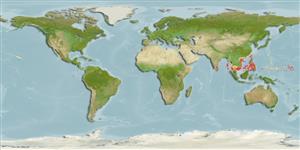>
Eupercaria/misc (Various families in series Eupercaria) >
Labridae (Wrasses)
Etymology: Paracheilinus: Greek, para = the side of + Greek, chaite = hair + Greek, odous = teeth (Ref. 45335).
Eponymy: Dr Kent E Carpenter is Professor of Biological Sciences at Old Dominion University, Virginia, USA. [...] (Ref. 128868), visit book page.
More on authors: Randall & Lubbock.
Environment: milieu / climate zone / profondeur / distribution range
Écologie
marin récifal; profondeur 27 - 45 m (Ref. 9710), usually 27 - 45 m (Ref. 27115). Tropical; 25°N - 5°N
Western Pacific: Philippines, north to Taiwan and Iriomotejima, south to northern Bali and Flores (Ref. 37816). Recently recorded from Tonga (Ref. 53797). Replaced by Paracheilinus mccoskeri in the Indian Ocean (Ref. 37816).
Taille / Poids / Âge
Maturité: Lm ? range ? - ? cm
Max length : 8.0 cm TL mâle / non sexé; (Ref. 9710)
Description synthétique
Clés d'identification | Morphologie | Morphométrie
Épines dorsales (Total) : 9; Rayons mous dorsaux (Total) : 11; Épines anales: 3; Rayons mous anaux: 9; Vertèbres: 25. In males, color is generally orange (yellow- or red-orange); lower fourth of head and body pale yellow; 2-4 dorsal soft rays prolonged (every other ray beginning with first). Males larger and more colorful than females; color of males intensify during courtship. Female specimens light red, pale white ventrally. Median predorsal scales 4-6 (Ref. 2139). Penultimate dorsal soft ray of males 1.8-2.2 in HL; two short dark stripes beneath pectoral fin (Ref. 41634).
Body shape (shape guide): fusiform / normal; Cross section: compressed.
Found on bases of steep outer reef slopes, above coral or rubble (Ref. 9710). Forms schools. Maximum depth reported from Ref. 27115.
Life cycle and mating behavior
Maturité | Reproduction | Frai | Œufs | Fécondité | Larves
Oviparous, distinct pairing during breeding (Ref. 205).
Randall, J.E. and R. Lubbock, 1981. Labrid fishes of the genus Paracheilinus, with descriptions of three new species from the Philippines. Jap. J. Ichthyol. 28(1):19-30. (Ref. 2139)
Statut dans la liste rouge de l'IUCN (Ref. 130435: Version 2024-2)
Menace pour l'homme
Harmless
Utilisations par l'homme
Pêcheries: commercial; Aquarium: Commercial
Outils
Articles particuliers
Télécharger en XML
Sources Internet
Estimates based on models
Preferred temperature (Réf.
123201): 23.9 - 28.2, mean 27.2 °C (based on 66 cells).
Phylogenetic diversity index (Réf.
82804): PD
50 = 0.5000 [Uniqueness, from 0.5 = low to 2.0 = high].
Bayesian length-weight: a=0.00977 (0.00470 - 0.02030), b=3.07 (2.90 - 3.24), in cm total length, based on LWR estimates for this (Sub)family-body shape (Ref.
93245).
Niveau trophique (Réf.
69278): 3.4 ±0.45 se; based on food items.
Résilience (Réf.
120179): Haut, temps minimum de doublement de population inférieur à 15 mois (Preliminary K or Fecundity.).
Fishing Vulnerability (Ref.
59153): Low vulnerability (10 of 100).
🛈
